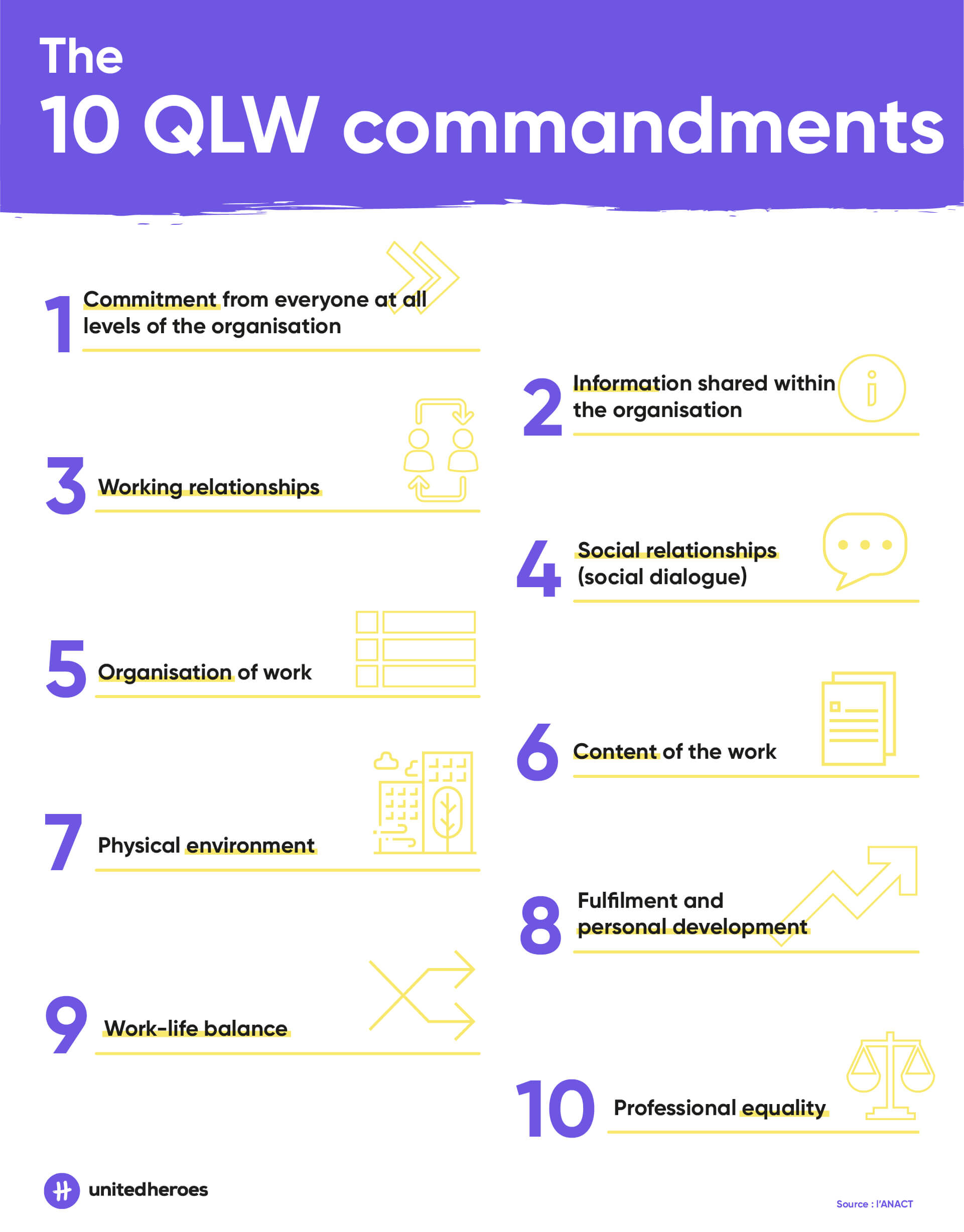
“And what do you do for a living?” This is a question that is becoming increasingly difficult to avoid whenever you meet anyone. And for good reason: while for centuries “work” meant only “subsistence”, times have changed and it is now essential to be fulfilled AT work in order to be fulfilled BY your work.
It’s got to be said that we spend most of our time there. It is therefore better to feel good about it if we don’t want to get caught up in an infernal mechanism from which it is very complicated to extract oneself.
This is why we talk about Quality of Life at Work. QLW for those in the know, and people in a hurry. Quality of Life at Work should give rise to well-being at work, that is the very reason for its existence. But again, the notion seems vague: is it a quantifiable reality, which can be compared between individuals because everyone feels the same way about it?
Fortunately, the World Health Organization (WHO if you want to expand your dictionary of acronyms) proposes a definition that it understands as being universal. It is “a state of mind characterised by a satisfactory harmony between the skills, needs and aspirations of the worker and the other constraints and opportunities of the workplace”.
OK? Is that not clear? Don't panic, let’s take a look at the indicators that measure how well employees’ chakras are aligned within the workplace.
The 10 QLW Commandments according to the ANACT

- Commitment from everyone at all levels of the organisation
- Information shared within the organisation
- Working relationships
- Social relationships (social dialogue)
- Organisation of work
- Content of the work
- The physical environment
- Fulfilment and personal development
- Work-life balance
- Professional equality
Commitment from everyone at all levels of the organisation
A committed employee is motivated to achieve the same objectives as his company. He shares the organisation’s vision and values and knows why he gets up in the morning. This is why all employees must be respected and their work must be valued whatever their position or type of contract.
Information shared within the organisation
Communication must be seamless and there must be many exchanges for a company to be successful. Indeed, the compartimentalization of information and teams could be detrimental to the continuous improvement measures that the company has now established. So communicate with your employees on a regular basis.
Working relationships
Employees are encouraged to communicate with each other all day long. Over time, if relationships based on trust (and sometimes based on friendship) develop, work will only become more interesting. Employees will enjoy spending time together while they work. These close relations allow turnover to be reduced. This is also the basis of the learning process, as good relations ensure the optimal use of skills.
Social relationships (social dialogue)
Social dialogue allows social partners and the company to negotiate and develop organisation in the workplace together. The objective of these discussions between trade unions and management is to allow employees to work together in the best conditions possible.
Strong unions and a regular dialogue allow the company’s performance to be evaluated, to suggest ways of improving work conditions and defuse conflicts before they develop.
Organisation of work
The way in which tasks are identified, organised, assigned and coordinated among employees has a major impact on their well-being. It must allow them to do their job in the best conditions (no stress, etc.) What is at stake is that the organisation of work contributes to the growth of the company: people don’t work in the same way in a VSB as in a major group.
Content of the work
For work to be considered interesting by employees, they must feel that their assignments serve a purpose. Therefore, an employee must understand the stakes and the aim of his tasks. The employee can thus see the real impact of his work. To improve their well-being further, employees should be able to vary their tasks to avoid repetition and boredom.
The physical environment
The quality of work and human relations, professional development and recognition are key features of the quality of life at work. But providing comfortable spaces (luminous, not too noisy, with the right temperature, etc.) has also become as an essential feature for the most attractive companies in just a few years.
Fulfilment and personal development
To be happy at work also means being able to develop your skills and advance your career.
A company which helps its employees to thrive and have more responsibility reduces turnover and cases of boreout. Bearing in mind that malaise at work costs companies on average €3,500 per employee, it’s better to do everything in your power to avoid it!
Work-life balance
Motivating assignments, recognition, an agreeable work environment and positive company values must not overshadow the work-life balance. For you to be happy at work, it mustn’t encroach upon your personal and family life. To achieve this, the right to disconnect or limiting overtime ensures that there is a separation between the spheres.
Professional equality
Equal opportunities ensure a better quality of life at work for everyone, whatever their sex, race or sexual orientation. Diversity is an opportunity for companies which are expanding. A company which has an equal opportunities policy, with workers that are equally qualified, attracts talents from all backgrounds and limits select communities which are detrimental to the emergence of new ideas.
So, what are you waiting for to obey the 10 Commandments of Quality of Life at Work?



